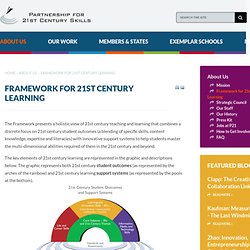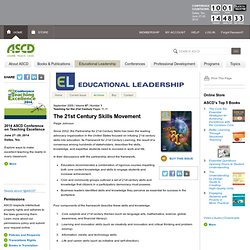

Newtoolsworkshop. Digital Literacy: Skills for the 21st Century: Introduction. This Digital Literacy Toolkit began with the premise that multimedia authoring, which is happening with the extensive use of PowerPoint in classrooms, must be taught as a skill, just as traditional text-based writing is taught. While teachers and students have become familiar with the technical skills required to use images in multimedia productions, they lack a critical language to determine whether an image or a sound is used appropriately. Images, sounds and animations — like words — are building blocks whose meanings can be changed to suit the communicative purpose of the author. Just as the same words and phrases can be arranged or manipulated to express different meanings depending on the author’s intent, so can sounds and images. The Partnership for 21st Century Skills - Framework for 21st Cen.
The Framework presents a holistic view of 21st century teaching and learning that combines a discrete focus on 21st century student outcomes (a blending of specific skills, content knowledge, expertise and literacies) with innovative support systems to help students master the multi-dimensional abilities required of them in the 21st century and beyond.

The key elements of 21st century learning are represented in the graphic and descriptions below. The graphic represents both 21st century student outcomes (as represented by the arches of the rainbow) and 21st century learning support systems (as represented by the pools at the bottom). While the graphic represents each element distinctly for descriptive purposes, P21 views all the components as fully interconnected in the process of 21st century teaching and learning. 21st Century Student Outcomes and Support Systems 21st Century Student Outcomes 1. 2. 3.
Skills 2.0. Skills 2.0 is now part of this month’s Work/Learning Blog Carnival hosted by Manish Mohan.

My article in T&D, the journal of ASTD, was published this month, and if you’re a member of ASTD you’ll see it in the monthly journal or you can access it online. I’ve attached the article below. This article covers issues that I often refer to on this blog and there is little new for regular readers. It is geared toward learning professionals who may want to know why it’s important to understand the Web for training and development. Download PDF: L&D Skills 2.0 I submitted this post for the work/learning carnival because it synthesizes much of my writing about learning on the Web. Enabling learning is no longer about just disseminating good content, if it ever was. Today I came across an excellent example of collaborative learning used by Ken Caroll in training language hosts: At the moment, we’re in the process of inducting (training?)
21 Century. Aligning 21st Century Learners with 21st Century. Web 2.0 Guru - home. Teaching for the 21st Century:The 21st Ce. Since 2002, the Partnership for 21st Century Skills has been the leading advocacy organization in the United States focused on infusing 21st century skills into education.

Its Framework for 21st Century Learning, the result of a consensus among hundreds of stakeholders, describes the skills, knowledge, and expertise students need to succeed in work and life. In their discussions with the partnership about the framework, Educators recommended a combination of rigorous courses imparting both core content knowledge and skills to engage students and increase achievement. Civic and community groups outlined a set of 21st century skills and knowledge that citizens in a participatory democracy must possess. Business leaders identified skills and knowledge they perceive as essential for success in the workplace. Four components of the framework describe these skills and knowledge: In 2005, the partnership began the State Leadership Program. The Partnership for 21st Century Skills - Home.